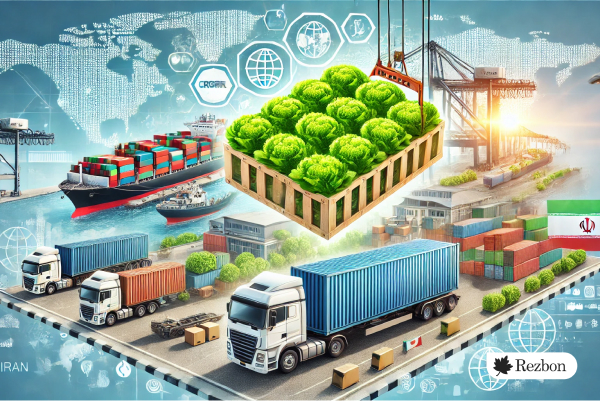Iran is a country with a rich agricultural history, offering a variety of high-quality crops to global markets. Among its many exports, lettuce stands out as a versatile and highly sought-after vegetable. Known for its crisp texture, vibrant color, and exceptional freshness, Iranian lettuce has carved a niche in international markets. Whether you are a wholesaler, a retailer, or part of the food services industry, importing lettuce from Iran can be a highly profitable venture if executed correctly.
In this detailed guide, we will walk you through the entire process of importing lettuce from Iran, discuss key considerations, and highlight how Rezbon, a leading player in agricultural trade, can streamline the process for you.
Why Choose Lettuce from Iran?
Iran’s unique climatic conditions and fertile soils make it a hub for high-quality agricultural products. With over 10 climate zones, the country produces lettuce varieties that thrive in different growing conditions. Iranian farmers use modern cultivation techniques alongside traditional farming practices, ensuring superior quality and sustainability.
Here are some reasons why importing Iranian lettuce is a smart choice:
- Diverse Varieties: Iran grows various types of lettuce, including iceberg, romaine, butterhead, and leaf lettuce, catering to a wide range of consumer preferences.
- High Nutritional Value: Iranian lettuce is rich in essential nutrients like vitamins A, C, and K, making it a favorite for health-conscious markets.
- Global Standards: With strict adherence to agricultural quality standards, Iranian lettuce is pesticide-controlled, organic-certified (in some cases), and meets export criteria for markets in Europe, Asia, and the Middle East.
- Cost-Effectiveness: Due to competitive pricing in Iran, importers benefit from reduced costs while maintaining high margins.
Step-by-Step Process of Importing Lettuce from Iran
1. Conduct Market Research
Before starting the import process, analyze your target market to determine demand for lettuce types, seasonal preferences, and pricing trends. Each market has specific preferences; for example:
- Iceberg lettuce: Popular for salads and sandwiches.
- Romaine lettuce: A staple in the food services industry, especially for Caesar salads.
Understanding market demand helps you select the right products to import. Rezbon provides valuable market insights to help you make informed decisions.
2. Identify Reliable Suppliers in Iran
Finding a trustworthy supplier is critical to ensure product quality, consistency, and timely delivery. Iran is home to many lettuce farms, but not all suppliers meet international export standards. This is where Rezbon steps in:
- Connecting you with verified farmers and exporters.
- Ensuring suppliers follow international quality standards and packaging requirements.
- Negotiating competitive pricing on your behalf.
3. Understand and Comply with Regulations
Each importing country has specific regulations for agricultural products. These include:
- Phytosanitary Certificates: Proof that the lettuce meets plant health requirements.
- Residue Testing: Compliance with maximum pesticide residue limits.
- Labeling Requirements: Country of origin, product type, and supplier details.
Failure to comply with these regulations can lead to shipment delays or rejection at customs. Rezbon’s experienced team ensures all documentation is accurate and compliant with your country’s regulations.
4. Arrange Transportation and Logistics
Lettuce is a perishable product, requiring careful handling and transportation to maintain its freshness. Choosing the right logistics solution is crucial:
- Use refrigerated containers with temperature control to prevent spoilage.
- Opt for expedited shipping methods, especially for long distances.
- Plan for efficient unloading and storage at the destination.
Rezbon specializes in cold-chain logistics, ensuring that your lettuce shipment arrives in peak condition, ready for distribution or sale.
5. Handle Customs and Import Duties
Customs clearance can be a complex process involving import duties, taxes, and other regulatory requirements. Partnering with a reliable customs broker simplifies the process. Rezbon works with experienced brokers and offers end-to-end support to minimize delays at customs.
Key Considerations for Importers
To ensure a successful and profitable import experience, keep the following points in mind:
- Seasonality: Iran’s lettuce production is year-round but peaks during cooler months. Importing during harvest seasons ensures better quality and pricing.
- Packaging: Ensure the lettuce is packaged in protective layers to maintain freshness and prevent damage during transit. Standard export packaging includes cartons with ventilation holes.
- Storage and Shelf Life: Lettuce has a limited shelf life, so plan for immediate distribution upon arrival. Keep the storage temperature between 0–5°C (32–41°F).
- Sustainability: Work with environmentally responsible suppliers who use water-efficient and pesticide-free farming practices.
Advantages of Partnering with Rezbon
When importing agricultural products like lettuce, having the right partner can make a world of difference. Rezbon is a leader in agricultural trade and offers a comprehensive range of services to facilitate seamless import experiences.
Here’s why Rezbon should be your go-to partner:
- Access to High-Quality Suppliers: Rezbon collaborates with a wide network of reliable Iranian farmers and exporters to source the best-quality lettuce for you.
- Regulatory Compliance Expertise: From certifications to customs clearance, Rezbon ensures all legal requirements are met, saving you time and hassle.
- Customized Logistics Solutions: With expertise in cold-chain logistics, Rezbon guarantees that your lettuce arrives fresh and ready for sale.
- Competitive Pricing: By leveraging its relationships with suppliers, Rezbon negotiates the best prices for its clients, ensuring you stay competitive in your market.
- End-to-End Support: From consultation to post-shipment assistance, Rezbon provides personalized support at every stage of the import process.


